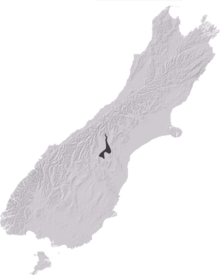Brachaspis robustus
| Robust grasshopper | |
|---|---|
| | |
| A female Brachaspis robustus | |
| Scientific classification | |
| Kingdom: | Animalia |
| Phylum: | Arthropoda |
| Class: | Insecta |
| Order: | Orthoptera |
| Family: | Acrididae |
| Genus: | Brachaspis Hutton, 1898[1] |
| Species: | B. robustus |
| Binomial name | |
| Brachaspis robustus Bigelow, 1967 | |
 | |
| The distribution of B. robustus in New Zealand | |
Brachaspis robustus is an endangered protected species of grasshopper from South Island, New Zealand.[2] Two species of grasshoppers are listed for protection under the Wildlife Act 1953 of New Zealand this include B. robustus and Sigaus childi.[3] Sigaus takahe is also protection under the Wildlife Act 1953 indirectly as it is only known from the Murchison Mountains Specially Protected (Takahē) Area. Brachaspis robustus is very distinctive from all other New Zealand grasshoppers as its escape behaviour is heavily dependent on its cryptic colouring and most time relies on motionless behaviour rather than active escape.
In 1993 it was estimated that were only approximately 800 adults in the wild.[4] By the end of 2009/2010 summer it is estimated that the adults populations has decline to approximately 600 adults. Whereby in 1993, most adults were found in three key very large populations and only a few sub-populations, by 2010, numerous new sub-populations have been discover, however, the three key populations from 1993 are now very sparse and made up of numerous sub-populations.
The genus Brachaspis is endemic to the South Island of New Zealand.
Distribution and habitat
Brachaspis robustus is only known from the Tekapo River system in the Mackenzie Basin. It can be found as far south as the Lake Benmore (44°20′29″S 170°12′42″E / 44.341511°S 170.211682°E) and as far north as the upper Fork Stream (43°58′24″S 170°24′04″E / 43.973351°S 170.400989°E). Brachaspis robustus is known between 352 metres (1,155 ft) on the lower Ohau River and 1,060 metres (3,480 ft) the upper Fork Stream, but prefer altitudes between 400–700 metres (1,300–2,300 ft). Detailed searches since 1980 have been carried out throughout the Mackenzie Basin and a good understanding of it current distribution is now known. Brachaspis robustus is always found in very rocky areas (stony floodplain terraces, fluvio-glacial outwash, recent fluvial outwash and rocky braided river), and never found in vegetation.[5]
Species description
The wings on B. robustus are micropterous (small wings) between 1–2 millimetres (0.039–0.079 in) making this species flightless like most of New Zealand grasshoppers. Male body length 18–22 millimetres (0.71–0.87 in); Female body length 38–42 millimetres (1.5–1.7 in). Males have 5 instars and female 6 instars this is identical to the other sub-alpine and alpine grasshopper species within New Zealand.[4]
Type information
- Bigelow, R.S. 1967: The Grasshoppers of New Zealand, Their Taxonomy and Distribution. University of Canterbury, Christchurch.
- Type locality: Ahuriri River, Otago. 44°27′29″S 169°56′09″E / 44.458143°S 169.935837°E. It is virtually certain that B. robustus is now absent from the Holotype and Paratype localities.[4][6] These localities and surrounding suitable habitat for B. robustus has been searched several times and have be unsuccessful.[6][7]
- Type specimen: Female; 21 April 1963; R.R. Granger; Holotype and Paratype is deposited in the Canterbury Museum, Christchurch.
- Type Specimen of B. robustus.
Polymorphism
Three colour morphs are known for adults B. robustus, 'Grey', 'Orange' and 'Black'. The must common form is the colour morphs 'Grey' at approximately 60% of the adults B. robustus, next is the colour morphs 'Orange' at 40% and the very rare colour morphs 'Black' at less than 0.5%.
- Colour morphs 'Grey'.
- Colour morphs 'Orange'.
 Colour morphs 'Black'.
Colour morphs 'Black'.
Mating
The ratio of male to female B. robustus alter for the duration of New Zealand summer. At the start of the summer in November the ratio of male to female is 56% male and 44% female. The only time that female B. robustus will out number the male is in December where the ratio is 43% male to 57% female. For the remaining summer the ratio continues to favour a stronger male to female ratio. In January at 54% males to 46% female to in March it is 82% male and only 18% female.[8]
Food habits
Brachaspis robustus is known to eat Anthosachne scabra (syn. Elymus rectisetus) and Poa pratensis, the herb Achillea millifolium, and unidentified mosses and lichens.[4] Faeces analysed during spring suggested that moss and lichen are important for the dietary of B. robustus. This might reflect the dietary importance of moisture absorption by these plants at night. Food succulence is important in grasshopper diets, and mosses and lichens may provide a means of withstanding the aridity and drought of the Mackenzie Basin.[4]
References
- ↑ Hutton, F.W. 1898: Notes on the New Zealand. Proc. Trans. NZ Inst. 31: 44-50
- ↑ Trewick, Steven A. (September 1, 2001). "Identity of an Endangered Grasshopper (Acrididae: Brachaspis): Taxonomy, Molecules and Conservation". Conservation Genetics. Springer Netherlands. 2 (3): 233–243. doi:10.1023/A:1012263717279.
- ↑ "Schedule 7 Terrestrial and freshwater invertebrates declared to be animals". Parliamentary Counsel Office/Te Tari Tohutohu Pāremata. Retrieved 23 December 2010.
- 1 2 3 4 5 White, E.G. 1994: Ecological research and monitoring of the protected grasshopper Brachaspis robustus in the Mackenzie Basin. Dept. of Conservation, Wellington, N.Z.
- ↑ Morris, S.J. Grasshopper Identification Sheet - Brachaspis robustus. Department of Conservation, Alexandra.
- 1 2 Morris, S.J. 2010: Monitoring Brachaspis robustus ~ 2009/2010 Summer. Department of Conservation, Twizel.
- ↑ Morris, S.J. 2005: The resurvey of the old historic Brachaspis robustus sites in the Mackenzie Basin. Department of Conservation, Twizel.
- ↑ Morris, S.J. 2005: Setting up of monitoring sites for Brachaspis robustus in the Mackenzie Basin. Department of Conservation.
| Wikispecies has information related to: Brachaspis robustus |